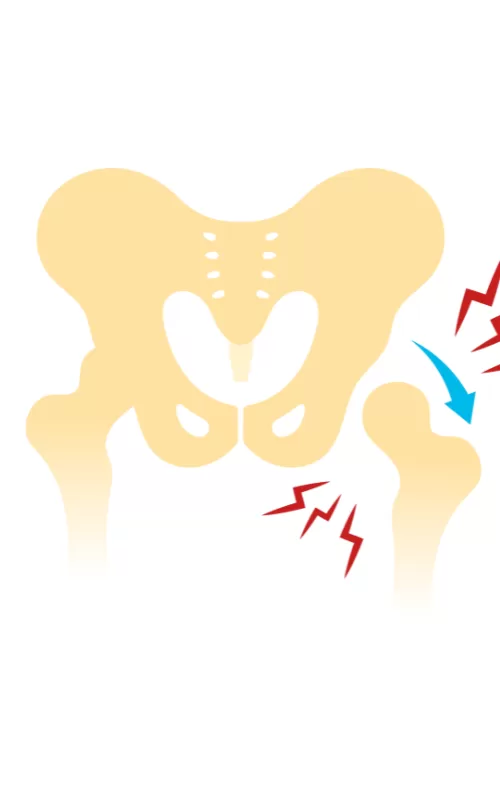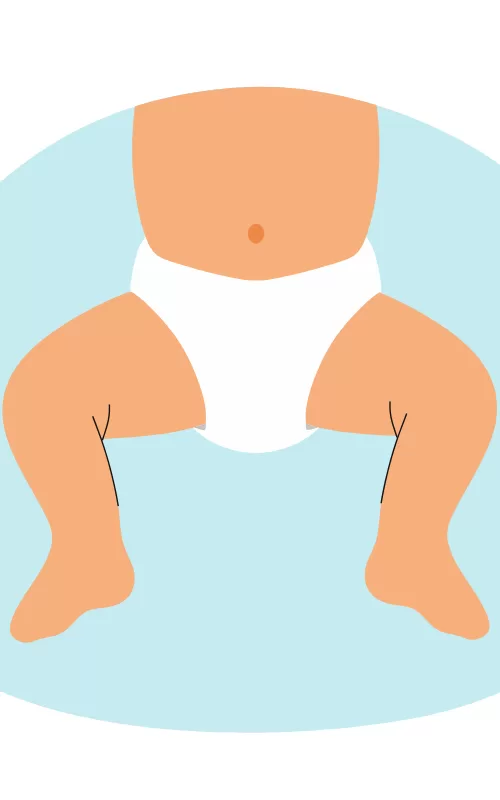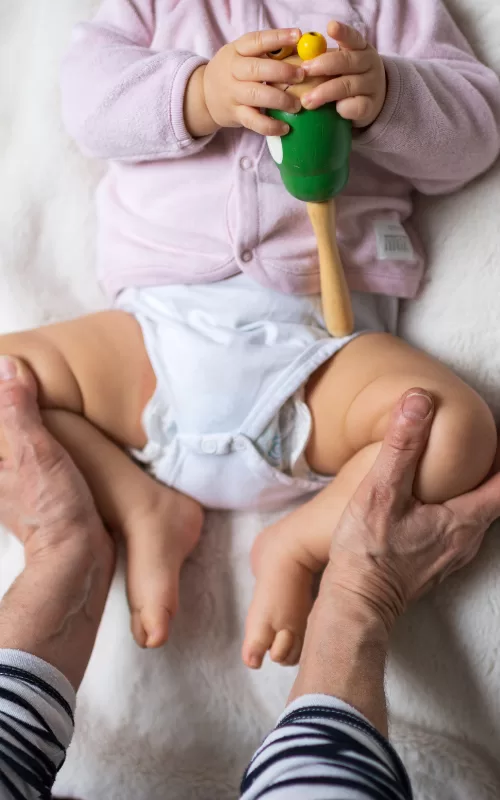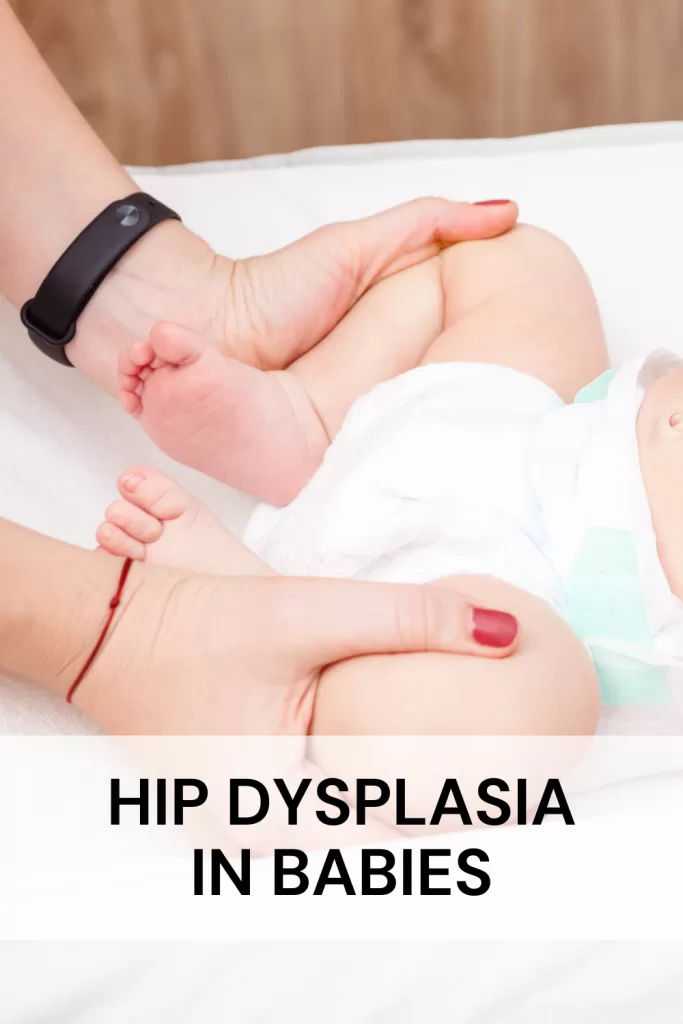Is hip dysplasia in babies worrying you? This post is for you.
DISCLOSURE This post may contain affiliate links, meaning if you decide to make a purchase via my links, I will earn a commission at no extra cost to you. As an Amazon Associate I earn from qualifying purchases. Thank you for your support.
Disclaimer: The information provided in this blog post is for educational purposes only and should not be used as a substitute for professional medical advice, diagnosis, or treatment. Always seek the guidance of your pediatrician or qualified healthcare provider with any questions you may have regarding your child’s health. If you think your child may have a medical emergency, call your doctor or emergency services immediately. Read our full Medical Disclaimer here.
Hip dysplasia in babies affects 1 in 100 newborns to some degree, yet many parents haven’t heard of this common condition until their own child receives a diagnosis. As a developmental problem of the hip joint, early detection and treatment lead to excellent outcomes in most cases. This post explores everything parents need to know about infant hip dysplasia, from causes and symptoms to treatment options and long-term outlook.
Our second child was born in the breech position (positioned buttocks-first in the womb) and her pediatrician requested an ultrasound to rule out hip dysplasia. She was seen by an amazing pediatric orthopedic surgeon Dr. Gleeson Rebello. We were scared by this possible diagnosis and she is being followed to make sure her hips develop as expected. Dr. Gleeson has been incredibly professional and even gave our 5 year old his book for kids “Darebone’s Big Break” that rhymes and teaches kids about bones and how to be careful while playing. In a matter of a week she had memorized the whole book! 🙂
So if your baby is going through the same possible diagnosis, fear not. You are not alone. Keep reading because this post was created with you in mind.
You might also like to read our post about Natural Fever Reducer for Kids: Safe Comfort for Unwell Little Ones and Feeding Bottle for Baby: Which One is the Best?
Hip Dysplasia in Babies: What Is Hip Dysplasia?
Hip dysplasia occurs when the ball and socket joint of the hip doesn’t form properly. In a healthy hip, the ball (femoral head) fits securely into the socket (acetabulum). With dysplasia, the socket may be too shallow, the ball may not sit properly in the socket, or both. This creates instability in the hip joint.
The condition exists on a spectrum of severity:
- Mild dysplasia: The socket is slightly shallow
- Partial dislocation (subluxation): The ball partially sits outside the socket
- Complete dislocation: The ball sits entirely outside the socket

Hip Dysplasia in Babies: Causes and Risk Factors
Doctors don’t fully understand all causes of hip dysplasia, but several factors increase a baby’s risk:
- First-born status: First-born babies face higher risk due to the mother’s tighter uterine and abdominal muscles
- Female gender: Girls develop hip dysplasia 4-5 times more frequently than boys
- Breech position: Babies positioned buttocks-first in the womb face 10 times higher risk
- Family history: If a parent or sibling had hip dysplasia, risk increases by 12%
- Oligohydramnios: Reduced amniotic fluid restricts fetal movement
- Tight swaddling: Traditional swaddling with legs straight and together can contribute to hip problems
Hip Dysplasia in Babies: Signs and Symptoms
Hip dysplasia often causes no pain in infants, making detection challenging. Parents should watch for:
- Asymmetrical skin folds on the thighs or buttocks
- Limited range of motion in one leg
- One leg appearing shorter than the other
- Delayed crawling or walking
- Waddling gait when beginning to walk
- Clicking or popping sound from the hip (though many clicks are normal)

Hip Dysplasia in Babies: Diagnosis
According to the American Academy of Pediatrics, Pediatricians screen for hip dysplasia during regular check-ups, particularly in the first six months. Diagnostic approaches include:
Physical examination: The doctor performs specific maneuvers like the Ortolani and Barlow tests to check for hip instability.
Imaging: When doctors suspect hip dysplasia, they confirm with:
- Ultrasound: Preferred for babies under 6 months since their hip cartilage hasn’t ossified
- X-rays: More effective for babies over 6 months once bone formation progresses
Hip Dysplasia in Babies Treatment Options
Treatment depends on the baby’s age and severity of the condition. The goal remains the same: position the hip properly to promote normal development.
For Newborns to 6 Months: The Pavlik harness serves as the standard treatment. This dynamic fabric brace holds the baby’s hips in a flexed and abducted position (frog-leg position) while allowing some movement. Babies typically wear it 23 hours daily for 6-12 weeks. Success rates reach 90% when started before three months of age.
For Babies 6-18 Months: If the Pavlik harness fails or diagnosis comes later, doctors may recommend:
- Closed reduction: Under anesthesia, the doctor manipulates the hip into proper position
- Spica cast: A body cast maintains proper hip position for 2-4 months
- Traction: Used before closed reduction in some cases
For Older Children: Surgical intervention becomes more likely, including:
- Open reduction: Surgery to remove obstacles and place the hip in the socket
- Femoral or pelvic osteotomy: Reshaping the bone to improve fit

The Treatment Journey
Parents find treating hip dysplasia challenging but manageable. The Pavlik harness initially presents difficulties:
- Diaper changes require adjustments
- Bathing happens when the harness comes off for the daily hour
- Clothing needs to accommodate the harness
- The baby may experience initial discomfort
Most babies adjust within days, and parents develop routines. Online parent support groups offer valuable tips for harness management.
Long-Term Outlook
When detected and treated early (before 6 months), hip dysplasia resolves completely in about 95% of cases without long-term complications. Even with later treatment, most children develop normal hip function.
Without treatment, babies face:
- Abnormal walking
- Leg length discrepancy
- Early-onset arthritis
- Potential hip replacements in early adulthood
Even after successful treatment, pediatricians will monitor hip development through childhood.
Prevention Strategies
While you can’t prevent all cases of hip dysplasia, certain practices promote healthy hip development:
Proper swaddling: Use “hip-healthy” techniques that allow leg movement. The International Hip Dysplasia Institute recommends swaddling with the legs able to bend up and out at the hips.
Baby carriers: Choose carriers that support the thigh and allow the legs to spread naturally in the M-position (knees higher than buttocks).
Avoid prolonged baby walkers: These devices don’t promote proper hip development.

When to Call the Doctor
Contact your pediatrician if you notice:
- Asymmetry in leg movement or appearance
- Limitation of hip movement
- Abnormal walking pattern
- Hip pain or limping in an older child
Supporting Your Baby Through Treatment
The diagnosis often overwhelms parents, but remember:
- Treatment works best when started early
- Babies adapt quickly to treatment
- The temporary challenges lead to lifetime benefits
- Following the treatment plan precisely maximizes success
Create a support system, connect with other parents of children with hip dysplasia, and maintain open communication with your medical team.
Conclusion
This post was all about hip dysplasia in babies. Hip dysplasia represents a common but highly treatable condition. Early detection through regular well-baby visits provides the best opportunity for non-surgical correction. Parents play a crucial role in identifying symptoms, adhering to treatment plans, and supporting their baby through the process. With proper care, children with hip dysplasia develop healthy, fully functioning hips and lead active lives without limitations.







Leave a Reply